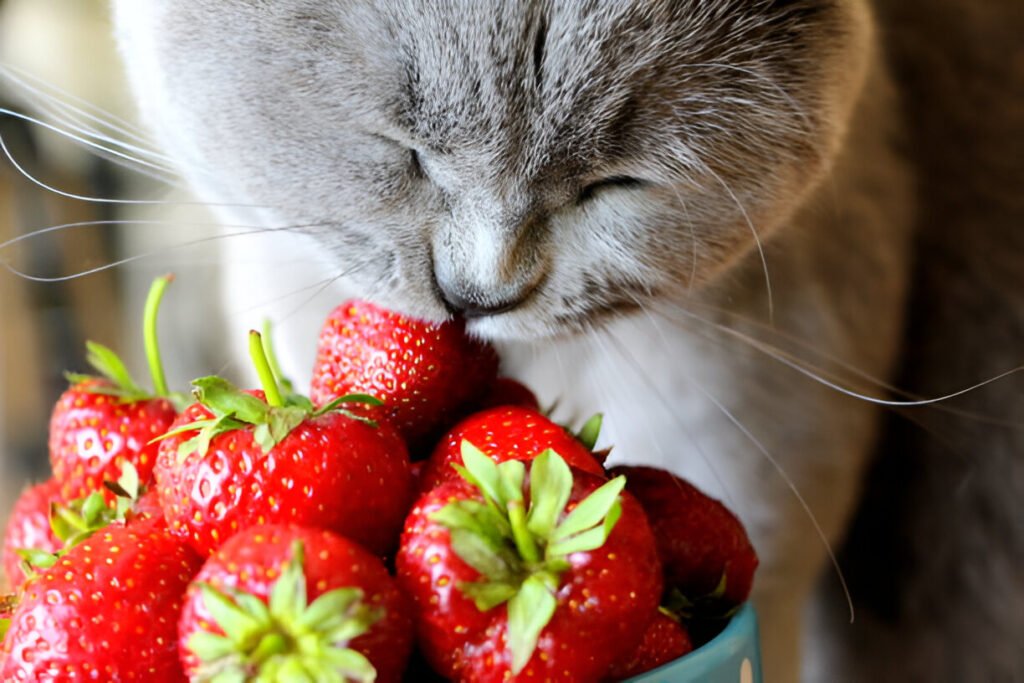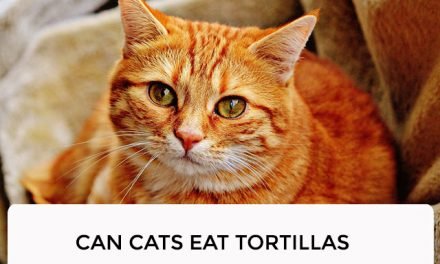Cats are curious animals, often exploring new foods with their noses. Owners may wonder if it’s safe to share a treat like strawberry with their feline friends. Can cats eat strawberries in moderation, but they should be prepared properly to avoid any digestive issues.
While strawberries are non-toxic to cats, not all felines enjoy the taste or texture. Some cats may show interest in the bright color or smell, while others might turn their heads in disinterest. It’s important for pet owners to be aware of their cat’s preferences and health needs when introducing new foods.
Before giving strawberries to a cat, they should be washed, hulled, and cut into small pieces. This helps prevent choking and makes it easier for them to eat. With caution and care, a small taste of strawberry can be a fun and different snack for cats.

Basic Facts About Cats and Strawberries
Cats and strawberries might seem like an uncommon pair. However, exploring their interaction can reveal important details about what’s safe for pets to eat.
Nutritional Content of Strawberries
Strawberries are low in calories and rich in vitamins. They provide:
- Vitamin C: Supports the immune system.
- Fiber: Aids digestion.
- Antioxidants: Help fight cell damage.
While these nutrients can benefit cats, strawberries also contain natural sugars. Too much sugar is not good for them.
The water content in strawberries can be hydrating. However, not all fruits are safe for cats. It’s crucial to note that even safe foods should be given in moderation.
Cats’ Dietary Requirements
Cats are obligate carnivores. This means they primarily need meat for nutrition. Their diet should include:
- Proteins from animal sources.
- Fats for energy.
- Specific vitamins and minerals.
Fruits like strawberries can offer a small treat but should not replace a cat’s main diet. Cats don’t require fruits for survival. Introducing new foods should always be done carefully.
If a cat has never eaten strawberries before, it is best to start with a small piece. Monitoring for any digestive upset is important.
Health Benefits and Risks
Cats may gain some benefits from eating strawberries, but there are also important risks to consider. It’s essential for cat owners to understand both sides before introducing this fruit to their pet’s diet.
Possible Health Benefits for Cats
Strawberries contain vitamins and antioxidants that can be beneficial. They are a source of Vitamin C, which helps support the immune system. This vitamin can assist a cat in fighting off illness.
Additionally, strawberries have fiber, which aids in digestion. The fiber can help maintain a healthy gut. However, it should only be offered in small amounts, as too much fiber can upset a cat’s stomach.
Potential Risks and Concerns
Despite some benefits, cats should eat strawberries carefully. Too much strawberry can lead to digestive issues. Diarrhea and vomiting are possible side effects of overconsumption.
The sugar content in strawberries is another concern, especially for overweight or diabetic cats. These cats may have difficulty processing sugar, making it crucial for owners to monitor the quantity given.
Allergic Reactions and Sensitivities
Some cats may be allergic to strawberries, though this is rare. Symptoms can include itching, swelling, or gastrointestinal upset. If a cat shows signs of an allergic reaction, it’s important to stop feeding strawberries immediately and consult a veterinarian.
It’s also essential to introduce any new food slowly. This helps determine if a cat has any sensitivities. A small piece can help assess tolerance without causing harm.
Feeding Guidelines
It is important to follow specific guidelines when feeding cats strawberries. These include the right serving size, frequency, and preparation methods to ensure safety and enjoyment.
Serving Size and Frequency
When introducing strawberries to a cat’s diet, it is best to start with a small serving. A good initial amount is about one to two small pieces. Cats should only have strawberries as an occasional treat, not a regular part of their meals.
Limiting frequency is key. Strawberries can be offered once a week. This helps prevent any digestive issues and keeps the cat’s diet balanced. Always consider the cat’s overall health and dietary needs before adding new foods.
Preparation and Serving Suggestions
Before offering strawberries, they should be washed thoroughly to remove pesticides. Removing the stems and leaves is also necessary, as they can be harmful.
Cut the strawberries into small, manageable pieces to make it easier for the cat to eat. Fresh strawberries are best, but frozen, plain strawberries can also be an option. Avoid adding sugar or other toppings.
Serve strawberries alone or mix them with a small amount of their regular food. Always observe how the cat reacts to ensure it enjoys the new treat and does not experience any adverse effects.
Alternative Treats and Foods
Cats can enjoy a variety of safe snacks that are nutritious and tasty. It’s important to know what treats are good for them, as well as those that should be avoided.
Recommended Cat-Friendly Snacks
- Cooked Meat: Plain, cooked chicken or turkey is a great option. Cats generally love meat and it provides essential protein.
- Cat Treats: Specially designed cat treats are formulated for their dietary needs. They often come in flavors like fish or liver.
- Pumpkin: Plain canned pumpkin (not the spiced pie filling) is safe. It aids digestion and many cats enjoy its flavor.
- Catnip: This herb is safe and often stimulates playful behavior. It can be given fresh or dried.
- Blueberries: In small amounts, blueberries can be a fun treat. They are packed with antioxidants and are low in calories.
Foods to Avoid
- Onions and Garlic: These can be toxic to cats. Even small amounts can lead to health issues like anemia.
- Chocolate: Chocolate is dangerous. It contains theobromine, which is harmful to cats.
- Grapes and Raisins: These can cause kidney failure in cats. It’s best to keep them out of reach.
- Dairy Products: Many cats are lactose intolerant. This means dairy can upset their stomach.
- Alcohol: Alcohol is extremely toxic. Even a small amount can result in serious health problems.
Understanding Feline Nutrition
Cats are obligate carnivores, meaning their diet must mainly come from meat. Their bodies need specific nutrients found in animal tissues.
Key Nutrients for Cats:
- Protein: Crucial for muscle growth and repair.
- Fats: Provide energy and support healthy skin and coat.
- Vitamins and Minerals: Aid in various bodily functions.
Cats do not require carbohydrates like humans do. While small amounts of fruits and vegetables can be okay, they should not make up a large portion of a cat’s diet.
Common Nutrients Cats Need:
| Nutrient | Importance |
|---|---|
| Taurine | Essential for heart and eye health |
| Arginine | Helps remove ammonia from the body |
| Vitamin A | Supports vision and immune function |
Always consult a veterinarian before adding new foods to a cat’s diet. Not all human foods are safe for cats.
In general, cats thrive on a balanced diet of high-quality commercial cat food. These foods contain the right mix of protein, fats, and other essential nutrients for a healthy life.
Interpreting Cat Behavior Around Food
Cats show specific behaviors that can give clues about their feelings toward food. Their actions can indicate interest, caution, or even fear.
Signs of Interest
- Purring: This sound often means contentment. A cat purring while near food may feel secure.
- Kneading: Cats might knead the ground or their owners when excited about food.
- Vocalizing: Meowing or chirping can show eagerness for a meal.
Signs of Disinterest
- Turning Away: If a cat sniffs the food and walks away, it might not find it appealing.
- Slow Approach: A cautious movement toward food can indicate uncertainty.
- Ignoring the Food: If a cat doesn’t investigate food, it may be uninterested or full.
Signs of Caution or Fear
- Hiding: A cat that hides when food is offered might feel anxious.
- Swatting or Growling: Aggressive behavior around food could arise from feeling threatened.
Understanding Portions
Cats can also show preference for portion sizes. They may nibble or eat quickly if they feel hungry.
Experimentation
It can help to try different foods. Observing a cat’s reactions can guide future meal choices.
Interpreting these behaviors can help owners meet their cat’s needs and preferences when it comes to food.
Frequently Asked Questions – Can Cats Eat Strawberries
Many cat owners wonder about the safety of strawberries for their pets. This section addresses common questions about whether Can catseat strawberries and what to consider when offering this fruit.
Are strawberries safe for cats to consume?
Strawberries are generally safe for cats in small amounts. They are non-toxic but should only be an occasional treat.
Can feeding my cat strawberry yogurt have any health implications?
Strawberry yogurt often contains sugar and other additives that can be harmful to cats. It is best to avoid offering flavored yogurts to ensure your cat’s health.
What fruits should be avoided to ensure a cat’s safety?
Certain fruits are toxic to cats. Grapes, raisins, and citrus fruits like oranges or lemons should be avoided to keep cats safe.
Is it okay for a cat to eat strawberry leaves?
Strawberry leaves are not toxic but can cause mild stomach upset. It’s better to avoid letting cats eat the leaves to prevent any digestive issues.
What reaction should I expect if my cat licks a strawberry?
If a cat licks a strawberry, it may not have any serious reaction. Some cats may be curious or interested, while others may ignore it altogether.
Are there any risks associated with cats ingesting strawberry seeds?
The seeds of strawberries are not toxic but can pose a choking hazard. It is advisable to remove the seeds or avoid feeding strawberries entirely to prevent any risk.





